Evaluation of the Remote Passenger Rail Program
(PDF, 1.02 MB)
Report outlining the results of the Evaluation of the Remote Passenger Rail Program.
On this page
1.0 Program background
1.1 Program context
Rail services are crucial for many remote communities, providing affordable transportation options and access to essential services, such as medical services, employment, and educational opportunities (2021 Funding document; Remote Passenger Rail Program Terms and Conditions).
The Remote Passenger Rail Program (RPRP) was created in 2005 to ensure the continued provision of passenger rail services, in certain established remote communities, where rail is the only means of surface transportation. Figure 7 in Appendix A illustrates the passenger trends over the last six years.
- A community is considered remote if it does not have year-round access to the national surface transportation system via a network of public or private roads. (2021 Funding document)
Currently, the RPRP supports two First Nations-owned railways: Tshiuetin Rail Transportation (TRT) and Keewatin Railway Company (KRC).
1.2 Program description
Located in northeastern Quebec and western Labrador, Tshiuetin Rail TransportationFootnote 1 was the first railway in North America to be owned and operated by a First Nations group and is jointly managed by Innu Takuaikan Uashat mak Mani Utenam, the Naskapi Nation of Kawawachikamach, and the Innu Matimekush Lac-John Nation. The company owns the track between Emeril and Schefferville and provides rail services between Sept-Îles and Schefferville.
For TRT, the RPRP provides both operational funding (e.g., for train fuel and crew salaries) and capital funding (e.g., for rail line rehabilitation, equipment acquisition, facility construction/maintenance).
Source: Natural Resources Canada (NRCan) Rail Network
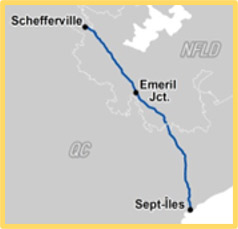
Located in Northern Manitoba, Keewatin Railway Company is jointly owned by Tataskweyak Cree Nation, War Lake First Nation, and Mathias Colomb Cree Nation. The company owns the track between Sherritt Junction and Lynn Lake and operates rail services between The Pas and Pukatawagan.
KRC receives capital funding only through the RPRP; it receives operational funding through a separate agreement with VIA Rail.
- Since entering into an operating agreement with KRC in 2006, VIA Rail has contributed an annual amount towards the company’s operating expenditures and reports on select financial details in its Annual Report (VIA Rail; 2006-2022).
Source: NRCan Rail Network
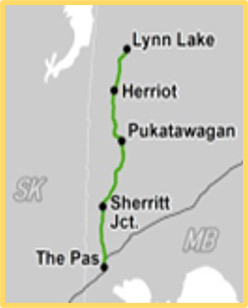
In support of the department’s core responsibility to provide an efficient transportation system, the RPRP funds the provision of safe, reliable, viable and sustainable remote passenger rail services while also contributing to the social and economic development of the remote communities located along the two railways.
In general, the expected results are to A) ensure the continuation of passenger rail services (with a minimum number of trips per year at an affordable cost for the users) and B) to support the efficiency of the railways, in terms of travel time.
The RPRP is delivered by TC’s Transportation Infrastructure Programs (TIP) branch, which is also responsible for preparing funding submissions.
- The RPRP draws on B-Base (temporary) funding and must periodically be renewed. After an extension is approved, the disbursement of funds is provided through contribution agreements between TC and each of the railways.
- During the last renewal exercise in 2021, the RPRP applied for 5 years of funding and was approved for three. Budget 2024 allocated $63.1 million over three years, starting in 2024-25, for Transport Canada to renew the RPRP.
Table 1 below shows actual spending by the RPRP from 2017-18 to 2022-23 (in millions), with disbursements totaling close to $72M over six years:
| Railway | Funding Type | 2017-18 | 2018-19 | 2019-20 | 2020-21 | 2021-22 | 2022-23 | Total |
|---|---|---|---|---|---|---|---|---|
| TRT | Operating | 6.74 | 7.59 | 7.50 | 7.50 | 9.00 | 9.30 | 47.63 |
| TRT | Capital | 1.64 | 2.45 | 2.05 | 1.98 | 3.00 | 3.10 | 14.22 |
| TRT | Sub-total | 8.38 | 10.04 | 9.55 | 9.48 | 12.00 | 12.40 | 61.85 |
| KRC | Operating | N/A | N/A | N/A | N/A | N/A | N/A | N/A |
| KRC | Capital | 1.65 | 1.65 | 1.65 | 1.65 | 1.73 | 1.75 | 10.08 |
| KRC | Sub-Total | 1.65 | 1.65 | 1.65 | 1.65 | 1.73 | 1.75 | 10.08 |
| Both | Grand Total | 10.03 | 11.69 | 11.20 | 11.13 | 13.73 | 14.15 | 71.93 |
Note that during the RPRP's previous renewal in 2021, funding was increased to reflect adjustments for inflation and the rising costs of operational requirements, particularly in remote/Northern regions.
In addition to regular program costs, recent renewals have included a one-off contribution to help address longstanding issues linked to ageing equipment and infrastructure:
- For example, in 2021, $34.2M in one-time funding was approved for KRC to acquire additional rolling stock and address safety and capacity issues.
1.3 RPRP results chain
Source: RPRP Terms and Conditions, 2020
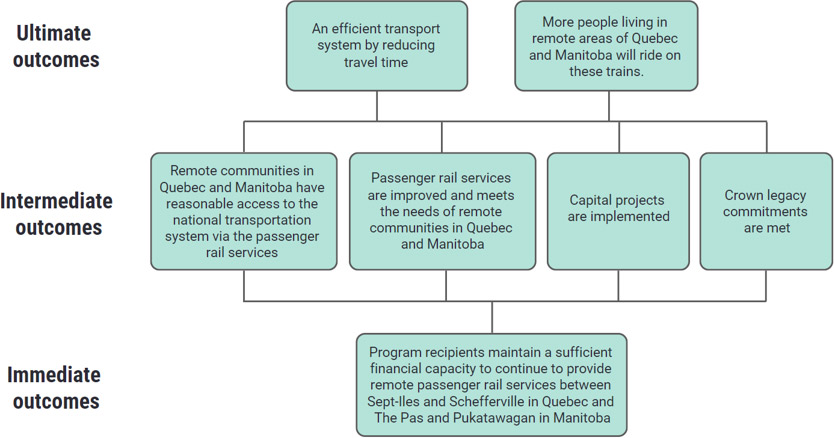
Long description
A hierarchical chart showing the immediate, intermediate, and ultimate outcomes for the RPRP.
The immediate outcome is "Program recipients maintain a sufficient financial capacity to continue to provide remote passenger rail services between Sept-Iles and Schefferville in Quebec and The Pas and Pukatawagan in Manitoba".
The intermediate outcomes are "Remote communities in Quebec and Manitoba have reasonable access to the national transportation system via the passenger rail services", "Passenger rail services are improved and meet the needs of remote communities in Quebec and Manitoba", "Capital projects are implemented", and "Crown legacy commitments are met".
The ultimate outcomes are "More people living in remote areas of Quebec and Manitoba will ride on these trains" and "An efficient transport system by reducing travel time".
2.0 Evaluation context
2.1 Evaluation background and scope
The RPRP is subject to the mandatory evaluation provisions listed in section 42.1 of the Financial Administration Act, which requires that all programs of grants or contributions, that meet a specific financial threshold, be evaluated every five years. Due to this requirement, RPRP has been evaluated on two prior occasions (2014 and 2018). This evaluation covers the period between 2017-18 and 2022-23.
2.2 Evaluation questions
The evaluation questions focused on the core issues of relevance, effectiveness, and efficiency/economy. The evaluation questions are listed in the RPRP Evaluation Matrix (see Table 5 of Appendix A).
2.3 Evaluation challenges and limitations
Most capital funding under the RPRP supports ongoing activities (such as track maintenance) rather than one-off projects with a defined start and end. As such, quantitative data describing funded capital projects were not readily available.
The RPRP must rely on TRT and KRC to provide data pertaining to each railway's operations, and in some cases the funding recipients lack the capacity to track these data consistently.
For KRC specifically, key operational data (such as the number of round trips per year) were not consistently available, as KRC reports these numbers to VIA Rail, rather than to TC, in accordance with their operating agreement (as described previously).
2.4 Evaluation methods
A mixed-methods approach was utilized. Data collection methods included the following:
2.4.1 Document review
Review of program documents, external documents such as news articles, and government priority setting documents, to inform issues of relevance and performance.
2.4.2 Interviews (11 interviewees)
Semi-structured individual and group interviews were conducted with:
- Program staff (5)
- Recipients (4) and
- Representatives from Rail safety (2)
2.4.3 Data review (where available)
- Review of performance-related data
- Review of program-related operational data
- Review of human resource and financial data
3.0 Findings
3.1 Program relevance
Finding 1: There is an ongoing need to provide passenger rail services to remote communities along the rail lines served by TRT and KRC. The RPRP addresses this need.
The RPRP aligns with the federal government's priority to support economic growth in remote and Indigenous communities and its commitment to ensuring reasonable access to the national transportation system for remote communities.
“The community we serve up north in Schefferville is very isolated, not accessible by road. The railway is the lifeline for the community in Schefferville. It’s an essential lifeline. Everyone depends on the railway company to go there, it’s a way to go south to join the rest of the province.” – Interview participant
There was consensus among interviewees that RPRP funding is essential to ensure the continued operation of passenger rail services. Several interviewees felt there was a risk that RPRP funding could be insufficient going forward given the rising costs of equipment, materials, labour, the maintenance of ageing infrastructure, and emerging factors like climate change.
There are limited sources of public funding available to the recipients beyond the RPRP. Though the recipients can access limited funds through bank loans and TRT has some revenue from their freight operations, both railways depend on RPRP funding to maintain their operations.
- Paying interest on loans and lines of credit also absorbs funds that could otherwise be used to purchase equipment or perform track maintenance.
“No, we could not maintain rail passenger safety and reliability without federal funding. Almost 100% of the program funds [are used] to maintain the tracks. In Manitoba [there are] harsh weather conditions.” – Interview participant
Federal funding for passenger rail services in remote communities is essential to ensure that individuals from these communities can access the ground transportation network and access essential medical services, as well as educational and employment opportunities.
The remote communities served by TRT and KRC do not have year-round access to roads. Further, these communities have limited access to winter roads. For example, one interviewee noted that the winter road in Pukatawagan is now only accessible for one month (instead of three) due to climate change. Interviewees also confirmed that no new roads have been built (and that it would be too costly to build) in these remote areas.
Though Pukatawagan and Schefferville have access to small airports in their communities, travelling by air is not a feasible option as air tickets are very costly.
- The price of a round-trip plane ticket to The Pas and Sept-Iles would be approximately $800 for residents of Pukatawagan (KRC) and $1 900 for those in Schefferville (TRT), respectivelyFootnote 2. This cost is prohibitive for many residents when compared to the cost of a round-trip train ticket (approximately $100 for KRC and $175 for TRT).
- In addition to being more expensive, travel by air is often less flexible and offers limited capacity. Flights between The Pas and Pukatawagan only seat seven people and tickets must be reserved a week in advanceFootnote 3.
“TRT and KRC offer means of transportation that are essential and affordable to destinations for Indigenous communities that are otherwise isolated from the national transportation system.” – Interview participant
Evidence also suggests that RPRP funding supports positive social and economic impacts in the communities served by both railways.
Interviewees indicated that the Indigenous-owned and operated railways are a source of community pride and have helped to create jobs for the residents of Pukatawagan and Schefferville. Further, KRC's track maintenance teams are comprised of local Indigenous residents and 85% of all TRT employees are Indigenous (Rail Policy documents).
In July 2022, active wildfires threatened the community of Pukatawagan. KRC was instrumental in evacuating approximately 1 500 community members to safety. One interviewee noted that KRC incurred operating costs during this time that were well above average and that there was no way to recover them.
News article: “A Canadian Red Cross official in Manitoba estimates close to 2,000 people have been evacuated from a First Nation threatened by a wildfire over the last several days using planes, helicopters and trains.” (Canadian Press, 2022)
Source: Anthony Mayham/KRC
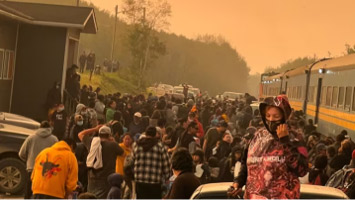
3.2 Program effectiveness
3.2.1 Assessment of RPRP indicators
Finding 2: TRT consistently surpassed the minimum thresholds for round trips and ticket prices during the evaluation period. KRC demonstrated strong performance in both indicators for the years with available data. However, incomplete data for KRC hindered a comprehensive assessment for the entire evaluation period.
TRT surpassed the target of 52 round trips from 2017-18 to 2022-23 with an average of 78 round trips per year.
Data for KRC was only available in 2019-20, where it exceeded the target. No data were available for other years (due to their operating agreement with VIA); however, program staff confirmed that KRC had consistently met the target during this period except for the 2020-21 fiscal year (due to COVID).
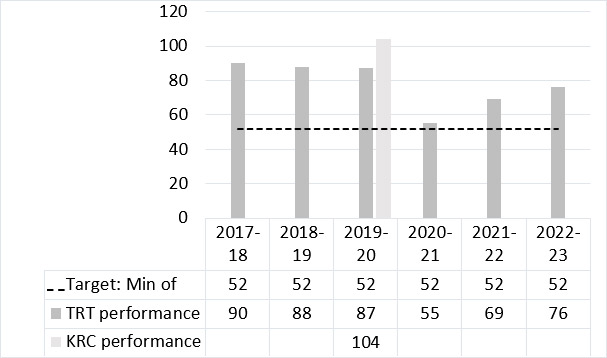
Long description
Bar graph and data table depicting the number of round trips per fiscal year for each railway, from 2017 to 2022. The target is a minimum of 52 trips per year.
TRT reported 90 trips in 2017-18, 88 trips in 2018-19, 87 trips in 2019-20, 55 trips in 2020-21, 69 trips in 2021-22, and 76 trips in 2022-23.
KRC reported 104 trips in 2019-20; data are unavailable for the other years.
TRT and KRC ticket prices met their goal by staying below a 30% increase compared to the prices in the previous years.
| Target: | Increase of less than 30% of the price in the previous year | |||||
|---|---|---|---|---|---|---|
| Railway | 2017-18 | 2018-19 | 2019-20 | 2020-21 | 2021-22 | 2022-23 |
| TRT | 0% | 0% | 0% | 0% | 0% | 0% |
| KRC | 2% | 2% | 2% | 25% | 0% | 0% |
Finding 3: Both TRT and KRC provided safe rail services from 2018-2022.
Although no specific safety performance indicator was specified in the RPRP results chain, safety is an integral component of the RPRP's overarching program objectives.
Between 2018 and 2022, there were no injuries or fatalities resulting from accidents or incidents for either KRC or TRT.

Long description
Bar graph and data table depicting the average 5-year accident and incident rates for TRT and KRC.
From 2018 to 2022, TRT had an average accident rate of 2.4 and an average incident rate of 2.
In the same period, KRC had an average accident rate of 0.2 and an average incident rate of 0.
Notes:
- Rail accident/incident rate is a TC departmental indicator for the result “A safe transportation system.”
- Evaluators determined that comparing the TRT and KRC results with the TC rate is inconclusive, primarily due to contextual variations and the lack of uniformity in the measurement strategy.
- The key difference between an accident and incident is the severity of the occurrence or the potential for injuries or fatalities, with accidents being more severe.
3.2.2 Capital projects and their impact
Finding 4: Capital funding is largely used to support critical ongoing activities such as maintenance and repair of infrastructure and equipment.
Interviewees conveyed that most capital projects for KRC and TRT were executed according to plan.
- There are specific challenges associated with completing capital projects in remote locations (e.g., harsh weather, transportation and availability of materials, increased cost of materials, etc.) and interviewees mentioned that the RPRP was flexible in managing/reprofiling funds when obstacles would arise.
- The program staff indicated that unlike projects with a clear start and end date, the TRT and KRC projects differ from typical major infrastructure projects as they involve ongoing activities like track maintenance, repair, and inspections.
Interviewees voiced concerns about the expenses linked to newly regulated safety equipment purchases, specifically the installation of cameras on trains.
“The challenge is it costs us about half a million to install these cameras, and the agreement is so rigid so we couldn’t ask for more money to cover this.” – Interview participant
Finding 5: Vegetation control along railway tracks poses a growing safety threat with potential implications for rail operations.
Rail safety inspectors noted that both TRT's and KRC's tracks are in good condition and both companies have sufficient maintenance programs.
An emerging risk that was noted for both railways was encroaching vegetation. If left unchecked, encroaching vegetation could lead to visibility issues, track degradation, wildlife hazards, and wildfire threats.
“The only major concern I had last year when I went to visit them was ... an abundance of vegetation...Vegetation could obstruct the rail or signs...” – Interview participant
“The one thing that … is going to compromise their operations, or going to make it more and more difficult, is station control and vegetation control. They don't have a good spray program.” – Interview participant
3.2.3 Impact of unforeseen factors on TRT and KRC performance
Finding 6: The adverse effects of the COVID-19 pandemic and other factors have heightened concerns about the need for contingency funding for emergency situations.
Interviewees emphasized the need for contingency funds (akin to those available through the National Trade Corridors Fund (NTCF)) to address urgent factors:
- The COVID-19 pandemic had negative impacts on both companies, leading to financial losses, workforce issues, and operational challenges.
- Extreme weather events like flooding and wildfires (which are increasing due to climate change) create safety and financial risks for both TRT and KRC. During the summer of 2022, KRC incurred additional operating costs by evacuating approximately 1 500 people.
- Ageing equipment and infrastructure lead to more frequent breakdowns and delays as well as higher maintenance costs.
These kinds of factors can impede the ability of both railways to deliver services and threaten the long-term viability of the railways’ operations, particularly in the context of rising equipment costs and supply chain issues.
"We’re also looking to have contingency funds because there are situations out of our control, for example climate change.” – Interview participant
Evaluation team question: “What could be done to improve the challenges encountered by funding recipients?"
Interview participant: “Funding stability. Contingency funds, as is the case for NTCF.”
3.2.4 Challenges in monitoring key indicators and requirements
Finding 7: Several program indicators are not consistently tracked for both railways.
Challenges in assessing RPRP performance indicators include:
- The limited reporting capacity of the recipients.
- Indicators copied from the overarching Transportation Infrastructure Performance Information Profile (PIP) (T30) that are not tailored to the RPRP (e.g., “Percentage of capital projects delivered on time, on scope and on budget”). See discussion under Finding 4 for more details.
- Certain indicators (not including the number of round trips made) were deemed not to be very useful or meaningful to collect by some program staff.
- Challenges in collecting sensitive Gender-Based Analysis Plus (GBA+) information, particularly from passengers. For instance, only one GBA+ indicator out of three was measured in six years.
- As observed in TC's Corporate Data Pathfinder, RPRP outcomes and indicators are not integrated into the Transportation Infrastructure PIP, as committed in the most recent RPRP funding document.
| Funding recipients | Performance Below Target | Performance Meeting Target | Data Unavailable | Total |
|---|---|---|---|---|
| TRT | 1 | 5 | 5 | 11 |
| KRC | 0 | 3 | 8 | 11 |
A total of 11 performance indicators were listed in the 2021 RPRP funding document (not including GBA+ indicators). For a complete list of indicator status, see tables 6 and 7 in Appendix B.
TRT: Out of the 6 indicators that evaluators were able to track, 5 met or exceeded their targets.
KRC: Even though there is no requirement to provide operational performance indicators to TC (because TC does not provide operational funding to KRC), the three available indicators met or exceeded performance targets.
3.2.5 Relationship with recipients
Finding 8: TC's relationship with recipients, particularly with TRT, has improved since the previous evaluation in 2018.
At the time of the previous evaluation of the RPRP in 2017-18, the relationship between TC and TRT was strained due to questions surrounding TRT's financial management. At the time, a compliance audit was conducted by an external consultant and recommendations were made to TC and TRT.
Current evaluation evidence suggests that TRT's financial reporting along with their relationship with TC has improved. TRT and TC have collaborated frequently over the past few years to discuss how to address previous recommendations. In general, the relationship is collaborative and more transparent than it was in the past.
“Since 2020, we have seen many improvements of the management and delivery of the program... because both of the recipients are collaborating with the department.” – Interview participant
“I think the relationship between TRT and TC, the one we have now it’s much better than it was at the beginning of the company from 2014-2018. So already here it helped a lot when negotiating 3 years ago.” – Interview participant
3.3 Program efficiency
Finding 9: The RPRP is delivered in an efficient manner as demonstrated by comparing the ratio of Operations and Maintenance costs (O&M) to the amount of contribution disbursements made.
A measure of efficiency, which has been used by some contribution programs at TC, is to calculate the ratio of O&M costs, which include Salaries and Other Operating Costs (OOC), to the value of contributions disbursed. As illustrated in Table 4, the ratio of O&M costs to the contributions disbursed ranged from a low of 0.60% to a high of 1.73% between 2017-18 and 2022-23.
The ratios in Table 4 increased to a high of 1.73% in 2021-22 and remained close to that level in 2022-23. The key reasons for this include the addition of a full-time equivalent (FTE) and hiring an external consultant in 2021-22, which increased the program’s salary and OOC expenditures. In 2022-23, the OOC includes the costs of travelling and conducting a site visit. Overall, the six-year ratio of total O&M funding to the total contributions disbursed was calculated at 1.06% (from 2017-18 to 2022-23).
Although no current departmental benchmark was identified by evaluators, having O&M spending be approximately 1% of all disbursements is deemed to be efficient and reasonable.
| Type of Expenditure | 2017-18 | 2018-19 | 2019-20 | 2020-21 | 2021-22 | 2022-23 | Grand Total |
|---|---|---|---|---|---|---|---|
| Salary | 55,833 | 57,231 | 60,512 | 60,512 | 146,714 | 146,714 | 527,516 |
| OOC | 17,757 | 12,512 | 11,200 | 11,200 | 90,160 | 21,840 | 232,989 |
| Sub-Total | 73,590 | 69,743 | 71,712 | 71,712 | 236,874 | 168,554 | 760,505 |
| Contribution disbursements | 10,030,000 | 11,690,000 | 11,200,000 | 11,130,00 | 13,730,000 | 14,150,000 | 71,930,000 |
| % of Contribution | 0.73% | 0.60% | 0.64% | 0.64% | 1.73% | 1.19% | 1.06% |
Finding 10: Program staff reported that the team is adequately staffed to deliver the program.
The RPRP is adequately staffed to deliver and manage the program activities. The number of FTE employees working on delivering the RPRP has increased since 2017-18. In the case of the RPRP, counting FTE numbers is not straightforward, since staff split their time between other transfer payment programs, but overall, the proportion of staff working on the RPRP has increased since 2017-18.
- Over the past five years, between 2018-19 to 2022-23, program staff have dedicated a significant proportion of their time preparing the required program renewal documents. The duration of RPRP funding has gone from a five-year cycle to a three-year cycle, requiring staff to prepare these documents more frequently.
In collaboration with TRT, by addressing the recommendations from previous compliance audits, the RPRP team has been able to make efficiency gains by only needing to review a sample of claims made by the railway. Previously (in 2017-18), RPRP staff thoroughly reviewed 100% of TRT's claims; in 2021-22, due to the improvements made to TRT's financial management, it was reported that the RPRP staff review about 10-20% of TRT's claims (which is comparable to the other transfer payment programs within the department).
4.0 Recommendation
The RPRP should refine and streamline their program outcomes and indicators, in collaboration with recipients, to ensure that it is feasible and useful to collect them.
5.0 Management Action Plan
| Recommendation | Action | Office of Primary Interest | Target Date |
|---|---|---|---|
| The RPRP should refine and streamline their program outcomes and indicators, in collaboration with recipients, to ensure that it is feasible and useful to collect them. |
|
|
All items are completed. |
6.0 Appendices
- Appendix A: Program and evaluation context
- Appendix B: Effectiveness tables
6.1 Appendix A. Program and evaluation context
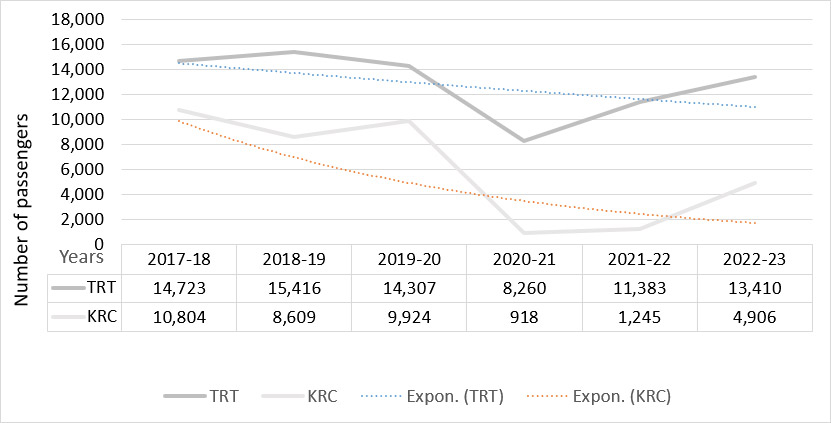
Long description
Line graph and data table depicting passenger trends for TRT and KRC from fiscal year 2017-18 to 2022-23. For both railways, passenger numbers dropped significantly in 2020-21 due to the pandemic.
TRT reported 14,723 passengers in 2017-18, 15,416 in 2018-19, 14,307 in 2019-20, 8,260 in 2020-21, 11,383 in 2021-22, and 13,410 in 2022-23.
KRC reported 10,804 passengers in 2017-18, 8,609 in 2018-19, 9,924 in 2019-20, 918 in 2020-21, 1,245 in 2021-22, and 4,906 in 2022-23.
| Evaluation Questions | Indicators |
|---|---|
|
Relevance: Is there a need for the RPRP? If so, to what extent is the program addressing the need? |
|
|
Performance: To what extent has the RPRP achieved its expected outcomes? What are the challenges? |
|
|
Performance: To what extent have Gender-Based Analysis Plus (GBA+) and Official Languages considerations been incorporated into program operations and activities? |
|
|
Efficiency and Economy: To what extent is the RPRP designed and delivered in an efficient manner? |
|
6.2 Appendix B. Effectiveness tables
| Indicator | Level | TRT measurement status | KRC measurement status |
|---|---|---|---|
| Percentage of expenses over revenue ratio | Short-term | Performance below target | Data unavailable |
| Number of round trips per year (as required in the contribution agreements) | Short-term | Performance meeting target | Performance meeting target |
| Percentage of train ticket prices increase compared to previous year | Med.-term 1 | Performance meeting target | Performance meeting target |
| Percentage of round trips completed versus planned | Med.-term 1 | Performance meeting target | Data unavailable |
| Number of passengers per year | Med.-term 2 | Performance meeting target | Data unavailable |
| Average passenger load factor per year (number of passengers per available seats) | Med.-term 2 | Data unavailable | Data unavailable |
| Percentage of departures with a delay of more than 15 minutes | Med.-term 2 | Data unavailable | Data unavailable |
| Percentage of projects delivered on time, on scope and on budget | Med.-term 3 | Data unavailable | Data unavailable |
| Payments are in accordance with the terms and conditions of the contribution agreements with the recipients | Med.-term 4 | Performance meeting target | Performance meeting target |
| Percentage reduction in passengers travel time from point to point according to the target duration objective, located on the portion of the railway owned by the recipient, as a result of track improvements | Long-term 1 | Data unavailable | Data unavailable |
| Percentage of growth in ridership using the trend of the last five years | Long-term 2 | Data unavailable | Data unavailable |
| Level | Outcome | Observation | Indicators | Observations |
|---|---|---|---|---|
| Short-term | Program recipients maintain a sufficient financial capacity to continue to provide remote passenger rail services between Sept-Iles and Schefferville in Quebec and The Pas and Pukatawagan in Manitoba | This financial capacity outcome is more relevant in the long term |
|
|
| Med.-term 1 | Remote communities in Quebec and Manitoba have reasonable access to the national transportation system via the passenger rail services | The outcome leans towards short-term, as providing “reasonable” access would be the first impact on the passengers |
|
|
|
Med.-term 2 |
Passenger rail services are improved and meet the needs of remote communities in Quebec and Manitoba | The second component “meeting the needs” of this outcome is broad |
|
|
|
Med.-term 3 |
Capital projects are implemented | N/A |
|
|
| Med.-term 4 | Crown legacy commitments are met | N/A |
|
|
| Long-term 1 | An efficient transport system by reducing travel time | N/A |
|
|
| Long-term 2 | More people living in remote areas of Quebec and Manitoba will ride on these trains | N/A |
|
|